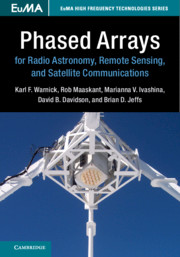Book contents
- Frontmatter
- Contents
- Preface
- Acknowledgements
- Notation and Units
- 1 Phased Arrays for High-sensitivity Receiver Applications
- 2 Active Antenna Receivers
- 3 Antenna Examples
- 4 Transmitting Arrays, Network Analysis, and Pattern Overlap Integrals
- 5 Array Receiver Theory and Modeling
- 6 Figures of Merit for Active Receiving Arrays
- 7 Design and Optimization of Phased Array Antennas
- 8 Numerical Modeling of Phased Array Antennas
- 9 Analog Front End, Array Elements, and Receiver Electronics
- 10 Array Signal Processing, Calibration, and Beamforming
- 11 Interferometric Arrays and Synthesis Imaging
- 12 Real Time Digital Signal Processing
- Index
- References
9 - Analog Front End, Array Elements, and Receiver Electronics
Published online by Cambridge University Press: 14 July 2018
- Frontmatter
- Contents
- Preface
- Acknowledgements
- Notation and Units
- 1 Phased Arrays for High-sensitivity Receiver Applications
- 2 Active Antenna Receivers
- 3 Antenna Examples
- 4 Transmitting Arrays, Network Analysis, and Pattern Overlap Integrals
- 5 Array Receiver Theory and Modeling
- 6 Figures of Merit for Active Receiving Arrays
- 7 Design and Optimization of Phased Array Antennas
- 8 Numerical Modeling of Phased Array Antennas
- 9 Analog Front End, Array Elements, and Receiver Electronics
- 10 Array Signal Processing, Calibration, and Beamforming
- 11 Interferometric Arrays and Synthesis Imaging
- 12 Real Time Digital Signal Processing
- Index
- References
Summary
Having discussed the basic theory and approaches to phased array receiver modeling, as well as figures of merit and system characterization, we now turn to specific details of the design and fabrication of the front end aperture itself. A wide variety of element types and configurations have been explored. Chief examples include the wideband sinuous element of the early explorations of PAFs at NRAO [1], dipole elements for PAFs [2], [3] as well as aperture arrays [4], tapered slot antennas or Vivaldi elements [5], [6], derivatives of the TSA element such as the egg-crate array, the checkerboard array [7]–[9] and other current-sheet implementations, horn elements [10], and of course the ubiquitous microstrip patch antenna [11] and the patch excited cup antenna designed by RUAG Space [12]. Many of these designs were surveyed in Chapter 1. In this chapter, we review considerations on selecting an appropriate element type, methods for design optimization, and fabrication issues. Receiver electronics is also discussed, with a specific focus on low noise amplifiers. Signal transport is also briefly addressed. The chapter concludes with an overview of downconversion and sampling, as well as the analog filters which these processes require.
Frequency and Bandwidth
Perhaps the most fundamental criteria in selecting an element type for a phased array system are the operating frequency and bandwidth. Frequency of operation might be considered the initial point in selecting an element, but because a given antenna type can be scaled, within fabrication limitations, to resonate or operate over a wide range of frequencies, bandwidth is in some ways the more critical driver. Element types can be divided most simply into narrowband, resonant antennas (dipole, patch) and wideband antennas (sinuous antenna, Vivaldi, checkerboard, and others). The division between narrowband and wideband is of course not a precise cutoff, but 10% to 20% relative bandwidth (i.e., bandwidth divided by the design center frequency), might be considered the upper limit of narrowband antenna types, and antennas with wider relative bandwidth would be considered to be wideband or ultrawideband. Bandwidth limitations are discussed further in Sec. 9.4.
- Type
- Chapter
- Information
- Publisher: Cambridge University PressPrint publication year: 2018



